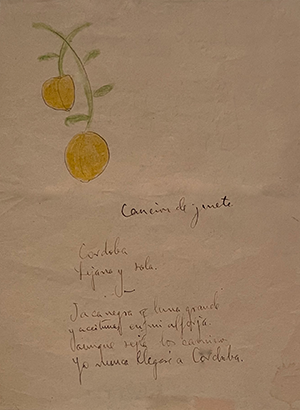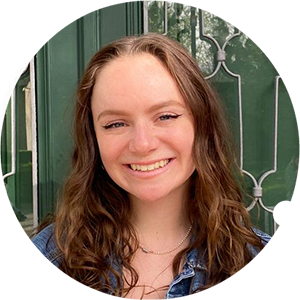
Translation is a complex task, as the translator not only needs to carefully consider word choices, verb tenses, tone, and rhythm, but must furthermore define the parameters of their role and responsibilities as a bridge between two languages and cultures. Traditional theories of translation view the translator as an invisible figure, whose goal is to produce a translation that blends as seamlessly as possible into the second language and culture. When our Introduction to Translation class took on the challenge of translating Federico García Lorca’s poem, “Canción de jinete,” we understood the aspect of risk inherent in our role as translators, as the act itself could mistakenly undermine the integrity of his piece. We also acknowledged that it was part of our responsibility as translators to take certain risks with our word choices in order to produce the best translation possible, one that would fully reflect the meaning and culture behind the original poem. We did not want to produce a poem that could be completely mistaken for an original English-language text, but rather we chose to allow those small moments of cultural disconnect to gently grate against our readers’ ears, bringing a touch of rebellion and boldness to the task of translating, as Spanish philosopher José Ortega and Gasset suggests translators should do in “Miseria y esplendor de la traducción”. Completely literal translations are often flat, not reflecting the creative work of the author’s original text; by taking risks, we hoped to honor the creative and artistic nature of the poem, capturing its meaning in a way that a literal translation could not achieve. Depending on the quality of the original work, one could argue that in some cases, a translation has the power to elevate the original (although we would certainly never make that argument in regard to García Lorca’s work), or that the translation is indeed its own separate, original work. While we did not attempt to improve García Lorca’s writing, we hoped to create a translation that would acknowledge and respect the original language and culture of the poem, while allowing English-speaking readers to connect with the deep emotions expressed in, “Song of the Rider.”
As translation provides space for risk taking, we did so in ways that aligned our translation with the meaning and intention of the original poem. In Stage Three of “The Eight Stages of Translation,” Robert Bly encourages translators to return to the literal translation of the poem that they created in Stage One, comparing it to the current version of the translation and the original poem in order to spot any places where the intended meaning may have been lost. At this stage, we focused on verb choices and tenses in the original poem. We particularly concentrated on two lines that used present subjunctive and future together in a way that seemed odd to us, especially when translated to English. The original poem included the phrase, “Aunque sepa,” (“Even if I knew”), using the present subjunctive of the verb, “saber,” (to know), paired with the future simple verb, “llegaré” (in the phrase “I will never arrive”) in the next line. While the mix of present subjunctive and future simple might not sound wrong in Spanish, it is not a common combination. A literal translation of these verb tenses to English sounded incorrect: “Even if I knew the way / I will never reach Córdoba.” We cannot be sure why García Lorca chose the subjunctive “sepa” instead of the present indicative “sé”; perhaps it was to maintain the meter of the line. In any case, “aunque,” is a conjunction that can mean, “even though,” or “even if,” depending on whether the verb it is paired with expresses an action that has already happened or is currently happening (indicative) or something that may happen in the future (subjunctive). In our translation, we chose to use subjunctive and conditional: “Even if I knew the way / I would never reach Córdoba.” The use of the future tense in the original poem, stating that the rider will never reach Córdoba, elicits a sense of certainty that contrasts with the use of subjunctive in the previous line (“Even if I knew the way”). We chose the conditional tense (“I would never reach Córdoba”) instead of the future tense to express the rider’s emotionally charged journey toward the understanding that he will not escape death. The rider’s literal and unattainable ride to Córdoba is a symbolic journey towards the realization of his death. By using the subjunctive and conditional in our translation, we felt that we were remaining faithful to the intention and uncertainty expressed in the original lines. This is one example of the many decisions translators must take, choosing when and why it is appropriate to veer away from the literal translation. Although any such decision is a risk, they often add to the creativity and artistic nature of the work, whereas a literal translation could result in a loss of meaning or emotional impact.
After checking to ensure that we had not lost any of the meaning of the original poem, we addressed Robert Bly’s assertion in Stage Three that the translator should try to revise the poem, “into English,” playing with word order to make the language flow more naturally in English, perhaps to the extent that the process of the translation is completely invisible. Bly furthermore expresses the need to translate the poem into “American” in Stage Four, stating that a poem needs to be updated every so often so that the reader gets the sense that a living person could have spoken the word of the poem. As a group, the class did not agree with these ideas. We believed that our role as translators was to serve as a bridge between two languages and cultures, without erasing the original culture or language. We furthermore found the concept of, “Americanizing,” a poem to be very problematic, as we did not see our role as translators to be that of packaging other cultures and languages into an easily digestible offering for readers in the United States. While we of course saw the need to make the poem accessible to audiences in the United States, we had no desire to eliminate the original author or culture. The erasure of the original author or culture is an example of the concept of, “white think,” which occurs when white scholars filter the history, perspectives, and culture of less dominant communities through a white and Western lens (López 142). We embraced the idea that an English-speaking reader should understand that they were reading something in translation. We did not intend to make the poem difficult for them to understand, but rather we wanted to make readers aware of the limitations of their understanding, which could encourage them to learn more about the culture behind the original text. As part of this conversation, we discussed whether to leave the accent on the city name of Córdoba. Some translations of the poem had included the accent, while others had not. We decided to leave the accent on Córdoba, as it would be an easy way to remind readers of the Spanish origins of the poem without impeding their understanding of the poem’s meaning in any way. In order to live in a less ethnocentric world, we believed it was our ethical duty to disregard Bly’s instructions and to not translate the poem with the intention of making it seem as, “American,” as possible. Translators often inhabit a unique space, where very few people have the linguistic ability to double-check their work. This makes translators the most powerful link in the communication chain of author-translator-readers. With this power comes the potential to abuse the role, to mistranslate for political or unethical reasons. As a class, we wanted to remain faithful to the intentions, emotions, and origins of the original poem, attempting to draw readers slightly out of their cultural comfort zone in order to acknowledge the culture behind the poem.
Our last steps in translating, “Canción de jinete,” involved a discussion of tone and rhythm, especially important and challenging when translating poetry. In the penultimate stanza, almost every line begins with exclamation marks and the interjection “Ay.” The class discussed the importance of these exclamation marks and interjections, as they show the building emotion that overtakes the rider as he approaches the end of his journey (death) and fully realizes the futility of his attempt to escape. We considered leaving the interjections as they were written in the original poem (“Ay”), as we thought this would be another relatively easy way to include a cultural and linguistic reminder that our poem was a translation without disrupting readers’ comprehension. We ultimately went with, “Oh,” instead, as when we read the lines out loud, we preferred the sound and flow of, “Oh,” over “Ay.” The sound and rhythm of the poem was another important consideration, as it must be with all poetry. In, “Canción de jinete,” the lines are short and individual words usually have few syllables. Only two words in the original poem have four syllables (“aceitunas” or olives, and “valerosa” or valiant), while all the rest contain one to three syllables. The combined brevity of the lines and words in the poem create a staccato rhythm that alludes to hoofbeats. When the poem is read aloud, the cadence evokes the sound of a horse and rider on a journey. We chose our words carefully, so as not to exceed four syllables in our translation, keeping the rhythm and sound reminiscent of a horseback journey.
The process of translation is an intricate puzzle, involving questions of ethics, individuality, and creativity. As we discovered in this project, the translator’s responsibility goes far beyond merely providing a grammatically correct rendition of a piece; instead, the translator must balance the perspectives and cultures of the author and readers, positioning themself as a powerful actor in the delivery of meaningful and emotion-filled material, including personal narratives, literature, and poetry. A responsible translator can serve as a bridge between cultures throughout the world without erasing the culture of the original text, exposing individuals to thought processes, beliefs, perspectives, and stories from across the world. This is what we attempted to achieve with our translation of, “Canción de jinete,” a poem that contemplates the universal nature of the emotions we experience on our journey through life toward the ultimate destination of death. ⬤
Bibliography
Bly, Robert. “The Eight Stages of Translation.” The Kenyon Review, vol. 4, no. 2, 1982, pp. 68-89.
López, Antonio. “Traduttore, Traditore—Translator, Traitor.” Counterpoints, vol. 343, 2008, pp. 141-7.
Ortega y Gasset, José. “Miseria y esplendor de la traducción.” Trama & Texturas, no. 19, 2012, pp. 7-24.
Special thanks to the Fall 2021 section of Introduction to Translation at UNI (Perla Arreguin, Emely Duron Portillo, Wendy Martin, Esme Najera, Steph Nees, Elise Parker, Stephany Perez Fernandez, Desi Shelton, Jessica Vrioni, and Sam Zimmerman) for their collaborative translation work throughout the semester, especially on “Canción de jinete.”
Read “Canción de jinete” via ProQuest
Discover More on the Craft of “Canción de jinete”




